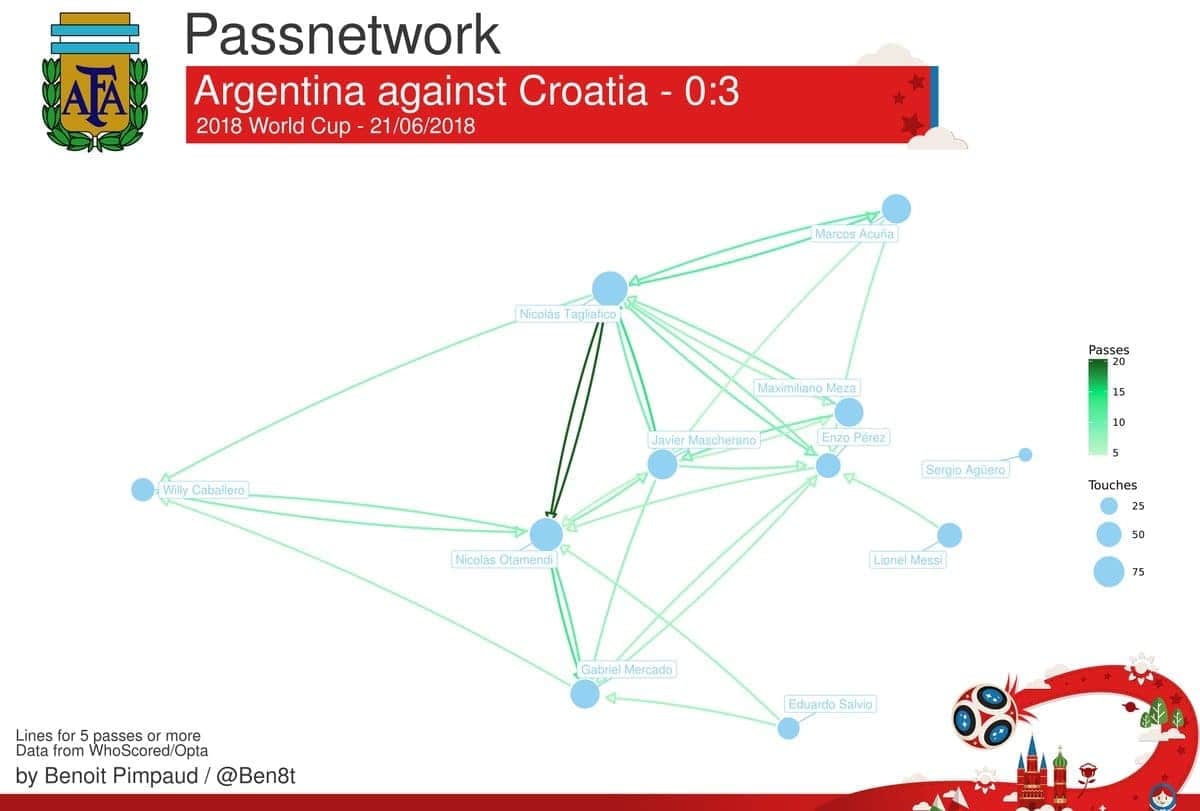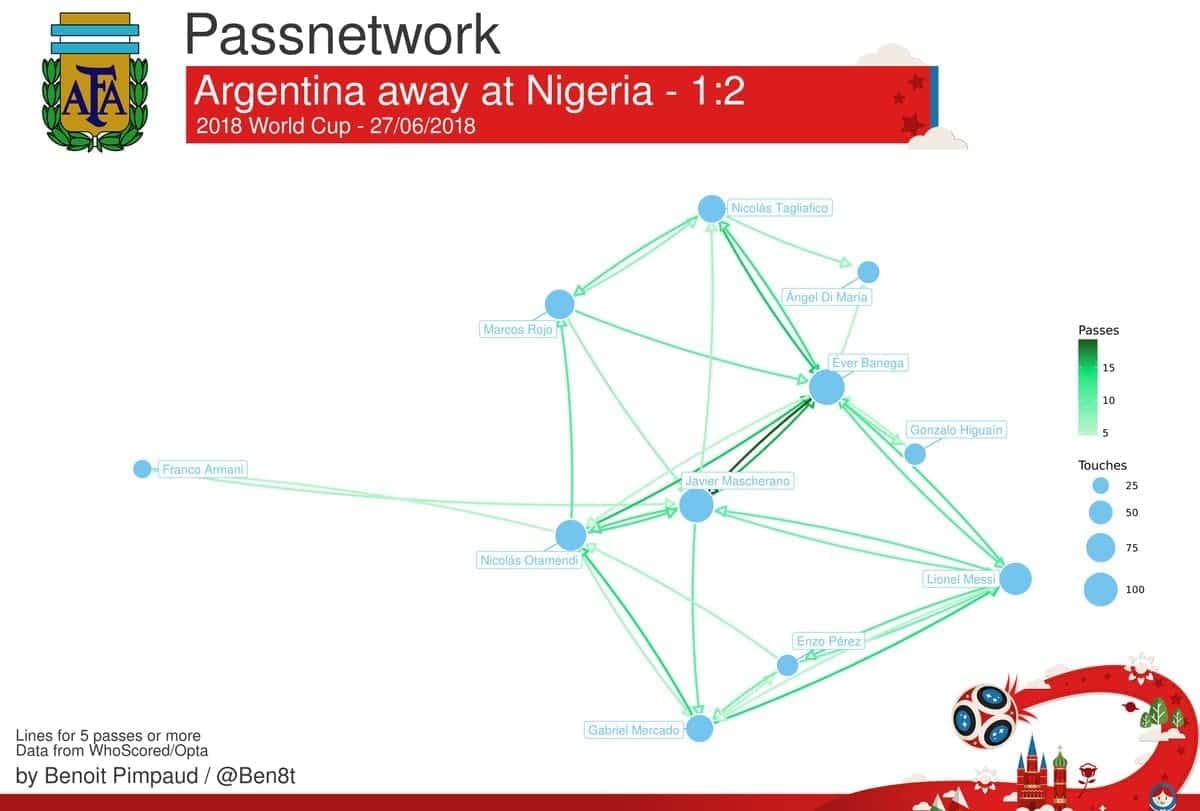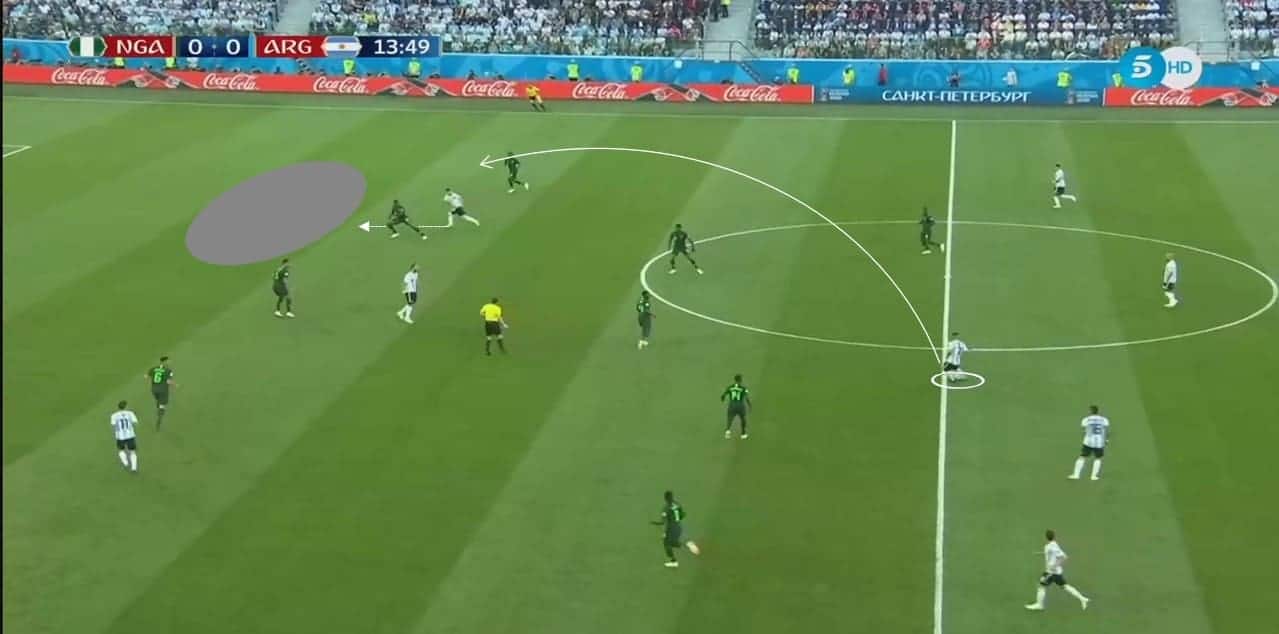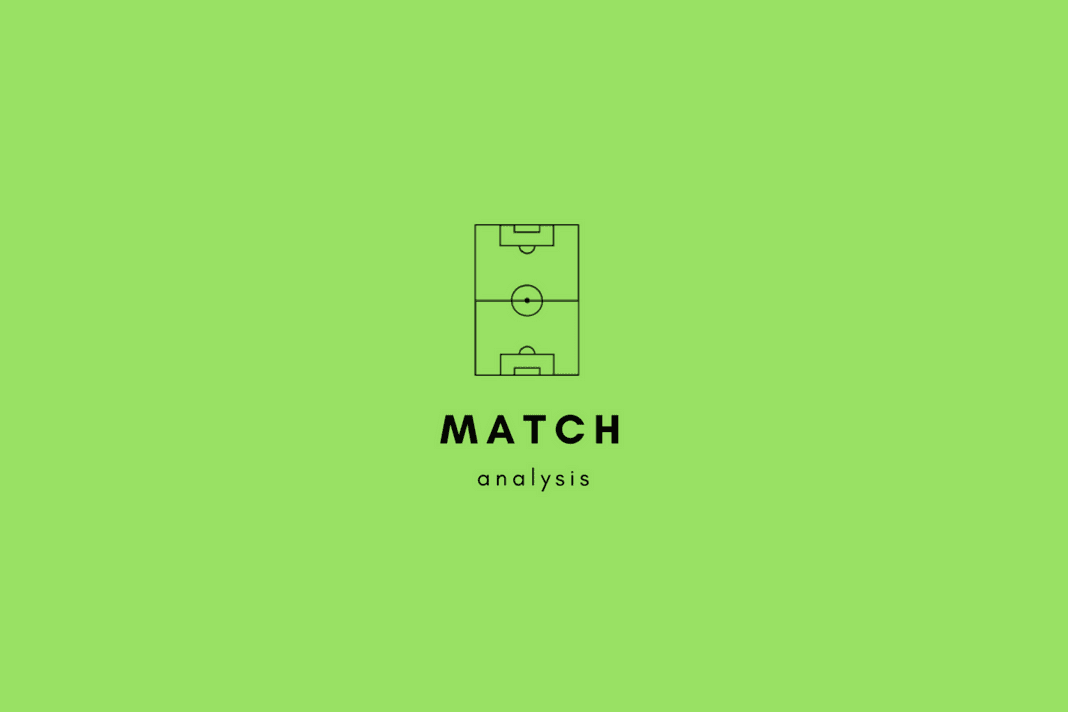Croatia’s surprising 3-0 win over Argentina put the Albiceleste in the verge of a shocking group stage elimination after just two games played in FIFA World Cup and highlighted the troubles of Lionel Messi’s side.
First and foremost, Argentina looked as a team poor in talent. They lack top players especially at goalkeeper, centre-backs, full-backs and wide midfielders. Argentina still faced a lot of problems during their qualification campaign through the World Cup. These problems led to the Argentinian FA changing three head coaches during qualification, with Jorge Sampaoli being the third one.
Former Chile manager Sampaoli is well-known to build his sides around furious pressing and a continuous variation of team’s shape in the way to make his team able to exploit opposition’s weakness. He’s also a strong believer in back three formations.
Sampaoli’s tinkering approach hasn’t really worked with the Albiceleste. He started his regime over there playing a three-man backline but abandoned it following the 4-2 collapse to Nigeria in a friendly game played in November. Subsequently, Sampaoli went to line up a four-man defence centred around Federico Fazio. In the debut game against Iceland, Sampaoli confirmed the four-man defence replacing Fazio with Marcos Rojo.
The reasons behind the 4-2-3-1 Sampaoli lined up against the Islanders was obvious. First, a fluid 4-2-3-1 morphing in a 2-3-3-1-1 when in possession, is the base Sampaoli’s formation utilized since he took the job over there. Then, the 4-2-3-1 shape looked more adapt to suit Messi.
As expected, Argentina retained ball possession and shoed interchanging offensive rotations between his players, especially when it came to Messi. In fact, into Argentinian fluid offence, Barcelona’s star often moved himself into the right half-space with full-back Eduardo Salvio providing width operating out wide on the right flank.
That said, an extremely compact Iceland was able to close the spaces in front of their defence. Heimir Hallgrímsson’s side was good enough to retain both horizontal and vertical compactness. They also closed well Messi every time Argentina’s no.10 get the ball in the middle. So, Messi had few spaces to operate in. Also, Messi’s teammates weren’t able to help their key player as their movements didn’t offer Messi’s good passing lines. It resulted in an offensive phase reduced to Messi dribbling against every Icelanders around him. Furthermore, with the central areas of the pitch so closed, Messi was often forced to collapse behind to help the midfielders to get the ball through the offensive third. It was also due to the fact that both Javier Mascherano and Lucas Biglia, playing in deeper midfield positions, lacked the needed dynamism to play as no.8 supporting the attack coming from behind.

Argentina was so forced to play in wider areas where Nicolas Tagliafico, Maximiliano Meza, and Salvio didn’t offer enough talent. Di Maria was the only skilfull footballer wide open, but he can’t contribute enough with his cutting inside movements until Tagliafico started to play higher up.
After this poor first display, Sampaoli went back to his original thought in the following game against Croatia. Argentinian coach lined up a three-man backline in a 3-4-2-1 shape featuring Gabriel Mercado e Tagliafico at the flanks of Nicolas Otamendi with Enzo Perez playing in the middle of the field alongside Mascherano.
By the way, neither this 3-4-2-1/5-2-3 formation worked. The midfield didn’t adequately press with the consequence that Albiceleste left a lot of spaces on the counter for the opposition. The fact that wing-backs were Salvio and Acuna contributed as both the players acted as offensive wingers with the result to leave the defensive centre-backs trio exposed.

When in possession, Argentina faced the same problems they experimented in the first game against Iceland. It means Croatia was able to overload the centre of the field denying Messi spaces between the lines. Just note as Luka Modric was a huge contributor on doing it. Also, Croatia was happy to low their first line of pressure leaving Sampaoli’s centre-backs free to play the ball. So, when Marcado and Tagliafico get the ball near to the midfield’s line, both Modric and Ivan Rakitic was effective in jumping up to press them also shadow covering Mascherano and Perez.
Focusing on close the central zones and shifting from side to side when Argentina played the ball wide open, Zlatko Dalic’s team closed Argentina passing lines forcing Otamendi, Mercado and Tagliafico to get the ball progressing up top through direct balls. Long balls behind the defence were the main route of attack for Argentina as the game gone through, Mascherano lowered his position becoming more involved in the build-up but it didn’t help Argentina to have offensively an impact.
Things improved just when Sampaoli introduced Gonzalo Higuain and Paulo Dybala in the second half. Especially Higuain had an impact on the game as Juventus’ striker stretched Croatia due to his skills to attack deep behind the opposing defence. Dybala too immediately showed the difference in terms of offensive talent when he replaced Salvio.
In the third and decisive game, against Nigeria, Jorge Sampaoli (or Javier Mascherano, the supposed shadow manager, who knows?) re-shaped Argentina in a basic 4-4-2 featuring Higuain up top alongside Messi, whilst Perez occupied the right centre-half with Di Maria playing out wide on the left. Argentina’s line up was more logical and more suited to the players than in the previous two games.

But, above all, he inserted Ever Banega in the middle of the field as the playmaker. With his great technical and passing skills and thanks to his vision, Banega drastically improved Argentina’s offensive phase in the first half of the game occupying the left half-space. Messi’s opening goal that put Argentina ahead 1-0 was due not just to no.10’s technical ability but also to Banega’s diagonal pass that found Messi.

The same Messi’s positioning on the right half-space was settled in a more fluid system that allowed Barcelona’s star to drew Nigeria’s backline attention, opening spaces for his teammates.
Unfortunately for Sampaoli’s side, things got worse in the second half: Banega slightly got out from the game while Mascherano started to act as the playmaker despite his poor passing play. Higuain has been ineffective up front whilst Di Maria too offered little. Argentina found Marcus Rojo’s goal to get his pass through the knockout stages, but this game too has been unconvincing. Sampaoli was good picking Cristian Pavon from the bench as the Boca Juniors’ player gave Albiceleste the needed width. But the same manager went wrong when he called Maximiliano Meza out from the bench.
Conclusion
All that said, Argentina’s main problems came as they failed to build dangerous attacks when in possession. Still, their defensive naïve approach didn’t help. Sampaoli has to take a look to the whole team’s tactical approach in the way to keep Argentina at this FIFA World Cup.
Against France, in the Round of 16, Argentina will have to take care of their midfield as French head coach Didier Deschamps will probably line up a 4-2-3-1 featuring N’Golo Kanté and Paul Pogba in the middle of the field. With their pace and physical skills, Kanté and Pogba could dominate the weak midfield Argentina showed so far. Things could become worse should Deschamps pick a three-man midfield featuring Blaise Matuidi too as the Juventus’ player would occupy the left half-space putting more pressure on Argentinian midfielders.
To have some chances to beat France, Sampaoli needs to control the game by controlling the ball. In the way to improve ball circulation, Argentina’s manager has to find a spot to Banega in the starting line up. Argentina also need to better support Messi. Barcelona’s no.10 likes enter in the middle of the pitch from the right half-space. So, opponents try to cover him compacting themselves in the half-space. Should France use a similar tactical approach, Argentina need to build other attacking options, on the right flank or on the weak side or also to give Messi the ball more quickly.
Argentina will have to use an adequate offensive structure in possession. Otherwise, France’s counter-attacking skills could hurt them.





Comments